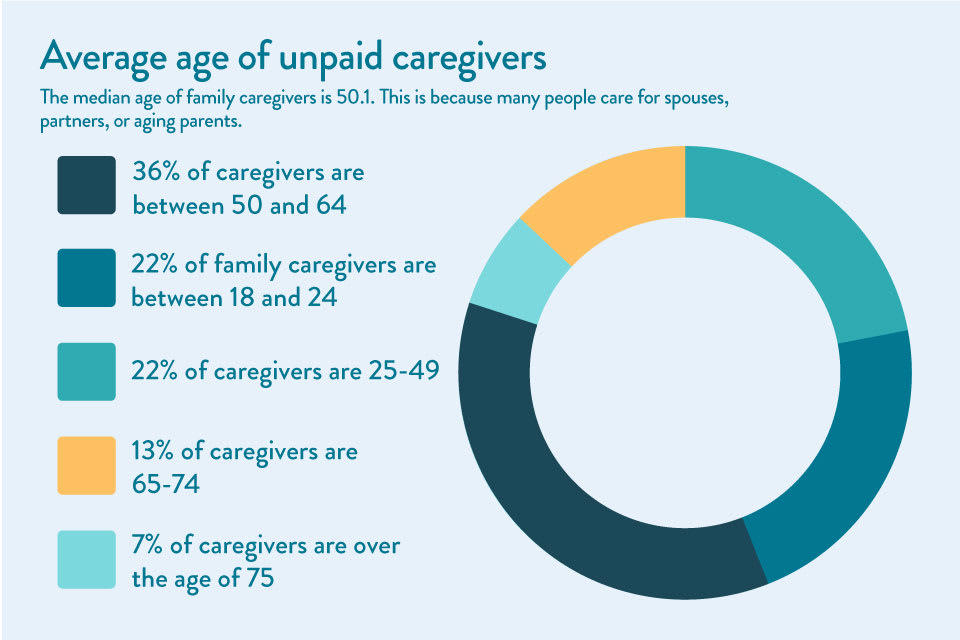We’re In This Together — Supporting Employee Caregivers
Have you wondered how significant the aging demographic and the caregivers who support them will be for your business’s future? It’s a question worth your attention.
In the dynamic landscape of modern business, recognizing the growth of the aging population and the strategic value of supporting community caregivers isn’t just a matter of goodwill. It’s also a pathway to attract and retain talent and secure your position in an aging-in-place society.
The statistics about the older adult population and caregivers are sobering, and the more you recognize and understand them, the more flexibility you have to positively affect the aging population and those who care for them:
- By 2040, about one in five Americans will be age 65 or older, up from about one in eight in 2000.
- The number of Americans ages 65 who most often need help with basic personal care will nearly quadruple between 2000 and 2040.
- Almost 17% of the U.S. adult population provides unpaid care to an adult over 50. More than 75% are women. Many of these caregivers are also employed or raising children of their own.
- Caregiver is the fastest-growing employee group, with 73% of all employees having some current caregiving responsibility.

As you examine the statistics above, it’s vital to remember that the numbers aren’t just abstract figures — they represent the demographic makeup of your workforce. One-third, 36%, of employees likely fall within the age group of 50 to 64, and another 22% are between 25 to 49.
These caregivers are your team members, innovators, and driving force. Understanding the growing significance of caregivers will lead you to recognize the challenges and responsibilities your employees may silently carry.
Supporting caregivers isn’t just a meaningful social responsibility; it’s an investment in your employees and your business’s future. With the current dynamic of aging and care and how the numbers will increase, you must recognize the growing preference for aging in place and discover the unsung heroes who make it possible.
The Growing Preference for Aging in Place
Seniors overwhelmingly prefer to age in place, staying in the homes they’ve cherished for decades. According to the AARP, in 2021, 77% of adults over 50 would prefer to age in place if given the choice.
This preference is not merely sentimental; it’s rooted in the desire for independence, familiarity, and autonomy. Aging in place enables seniors to maintain routines, keep close ties with their communities, enjoy continued control over their lives, and manage their finances more effectively.
However, this aspiration comes with challenges, as aging often brings various physical and sometimes cognitive health issues. These challenges are where the indispensable role of caregivers comes into play.
Caregivers become the linchpin of aging in place, providing the vital support that allows seniors to continue living in their cherished homes while ensuring their safety, well-being, and quality of life. The need for caregivers, whether family members, volunteers, or professionals for-profit and non-profit organizations, becomes apparent as older adults strive to age in place with dignity and comfort.
The Unsung Heroes — Caregivers
Caregivers provide crucial support with daily activities, medical care, emotional companionship, and more. They are the backbone of the aging-in-place movement by ensuring seniors can live their years with dignity and a high quality of life.
And not only the aging-in-place seniors face challenges, but also caregivers. On top of working, their caregiving responsibilities can be physically demanding, emotionally draining, and financially stressful. These responsibilities often lead to exhaustion and even burnout, negatively affecting their personal lives and, sometimes, their careers. Some statistics from AARP are as follows:
- 53% of caregivers believe they have no choice and feel trapped
- 4 out of 10 say caregiving has been emotionally stressful
- 23% say their health has worsened as a result of caregiving
- One in five caregivers report feeling a high degree of financial strain as a result of providing care
- 61% of family caregivers are also working
- 48% of adults provide financial support to their grown children, while 27% are their primary support. Additionally, 25% are financially supporting their parents as well.
Their dedication often goes unnoticed, but their contributions are immeasurable. Now, the question is, how can you, the business leader, identify these heroes within your workforce and, in turn, support them?
By acknowledging their responsibilities, offering greater flexibility, implementing caregiver-friendly policies, and providing resources, businesses can see and value their caregiver employees and attract and retain top talent.
You Can Support The Heroes In Your Organization
Caregivers need to be nurtured —listened to, validated, encouraged, and supported in their lives and challenges at home.
The Family Caregiver Alliance notes, “For many caregivers, their work is often a place to focus on something other than caregiving temporarily and to have an identity outside of being a caregiver.”
There are many ways you can support the caregivers in your company so they can not only take care of their loved ones but also continue their work for you, which they are committed to, and find some harmony while doing both. It’s in your and their best interest to help them care for themselves.
Offer Greater Flexibility
Offering flexibility to caregivers is a transformative step that businesses can take to support their workforce.
Flexibility can take various forms, such as flexible work hours, remote work options, or compressed work weeks. These adjustments allow caregivers to manage their caregiving responsibilities better while fulfilling their work duties.
And even more so, it demonstrates a commitment to employees’ work-life harmony, which enhances their satisfaction and retention.
Implement Caregiver-Friendly Policies
Implementing caregiver-friendly policies is a proactive way for businesses to demonstrate their commitment to supporting employees who are caregivers. These policies can include
- Flexible working arrangements
- Paid leave for caregiving responsibilities
- Access to counseling services
- On-site or virtual support groups
These policies give caregivers practical tools to manage their dual roles and communicate that their well-being matters.
By fostering a culture prioritizing work-life harmony and caregiving responsibilities, businesses create an environment where employees feel listened to, validated, encouraged, and supported.
This support increases job satisfaction, morale, productivity, and employee retention. Caregiver-friendly policies are not just an investment in individual employees but also an investment in the overall health and vitality of the organization.
Provide Resources
Equipping caregivers within your workforce with access to a comprehensive list of resources can be a game-changer. These resources may include educational materials, support networks, and guidance on available services.
Furthermore, establishing partnerships with local aging-in-place organizations can be invaluable. These organizations specialize in providing the necessary support and expertise in caring for seniors aging in place:
- Socialization
- Home maintenance services
- Well-being checks – in person and by phone
- Meal delivery
- Health and wellness programs
- Intergenerational activities
- And more
By providing these resources and connections with aging-in-place organizations in your community, businesses relieve some of the caregiving burden and empower their employees with the knowledge and tools they need to navigate this critical phase of life confidently. This proactive approach enhances employee well-being and creates a harmonious and productive work environment.
For Your Community — Donate Time and Money to Aging-in-Place Organizations
Donating time and money to aging-in-place organizations within your community is a powerful way for businesses to make a meaningful impact. With 77% of adults over 50 expressing their desire to age in place, it’s clear that the demand for caregivers will continue to rise, and these caregivers are employed while providing this crucial support.
Financial Contributions —
Financial contributions provide these organizations with the resources they need to offer essential services, from home modifications and healthy eating services to social programs, enabling seniors to age comfortably.
Time Contributions —
Additionally, encouraging and providing opportunities for your employees to volunteer their time can foster a culture of community involvement and social responsibility within your organization. These benefit the organization by improving its reputation as a responsible corporate citizen and building strong community ties and networks.
Most importantly, contributing to aging-in-place organizations and caregivers is an investment in the well-being of your community, aligning your business with a noble cause and leaving a lasting, positive impression on your employees and customers alike.
A Final Thought
“Businesses Supporting Community Caregivers for an Aging-in-Place Society” isn’t just a title—it’s a call to action.
With the growing preference for aging in place and the pivotal role played by the unsung heroes—caregivers- businesses have a unique opportunity to champion this cause.
By offering greater flexibility, implementing caregiver-friendly policies, providing essential resources, and donating time and money, organizations can become the driving force behind a more compassionate and supportive society for employees and the community.
The business of the future isn’t just about profit margins; it’s about people, relationships, and social responsibility. Supporting caregivers is not just a choice; it’s a strategic investment in a future where aging in place isn’t just a dream but a well-supported reality.
Click here to learn how your organization can contribute to the aging-in-place community and its caregivers.
Get Involved
You can help seniors age in place by supporting DuPage Senior Citizens Council.
You can DONATE to support our programs and services and you can VOLUNTEER to directly impact seniors in our community.
You can also join our CORPORATE PARTNER PROGRAM.
Sources
- National Library of Medicine, Aging in Place, Aug. 2022
- SHRM, Here’s How People Managers Can Support Employees Who Are Caregivers, Feb. 2023
- AARP, Caregiving in the United States 2020, May 2020
- Forbes, The ‘Sandwich Generation’ Is Financially Taking Care Of Their Parents, Kids And Themselves, Feb. 2023
- ALM Benefits Pro, A caregiver-friendly culture is a smart business strategy: Apply these 7 tips, Oct. 2022
More Articles That Might Interest You
The Caregiving Balancing Act: Support Systems for the Sandwich Generation
The Caregiving Balancing Act: Support Systems for the Sandwich Generation Are you juggling the dual roles of [...]
HR Champions of Aging-in-Place: Fostering Intergenerational Connections
HR Champions of Aging-in-Place: Fostering Intergenerational Connections Attention HR leaders and professionals! “ The more HR and [...]
Bridging Generations: Engaging Activities for Seniors and Youth
Bridging Generations: Engaging Activities for Seniors and Youth Pt. 2 Calling all adult children of seniors, parents, [...]










